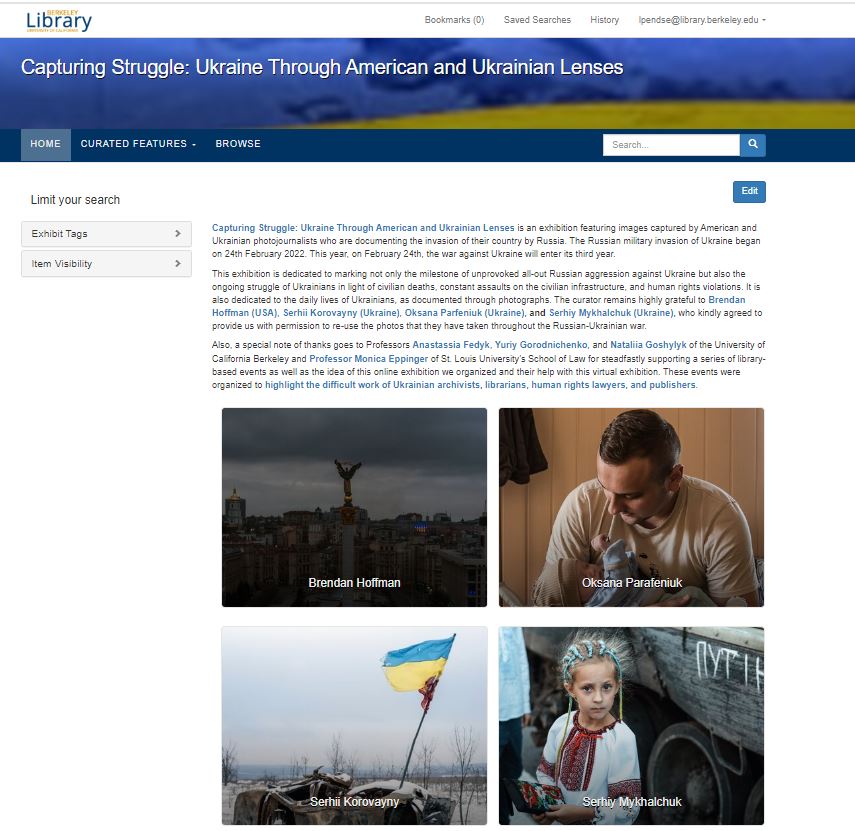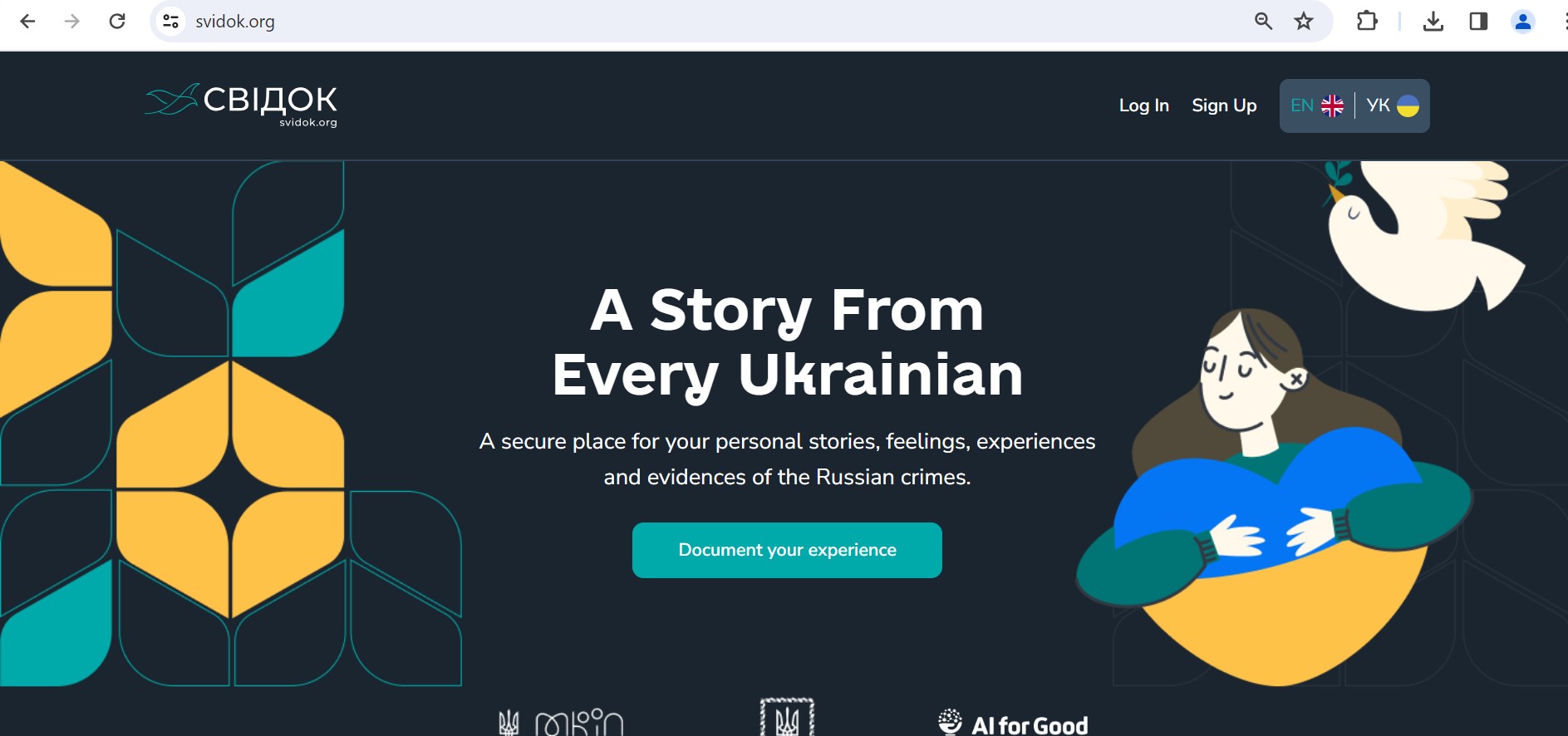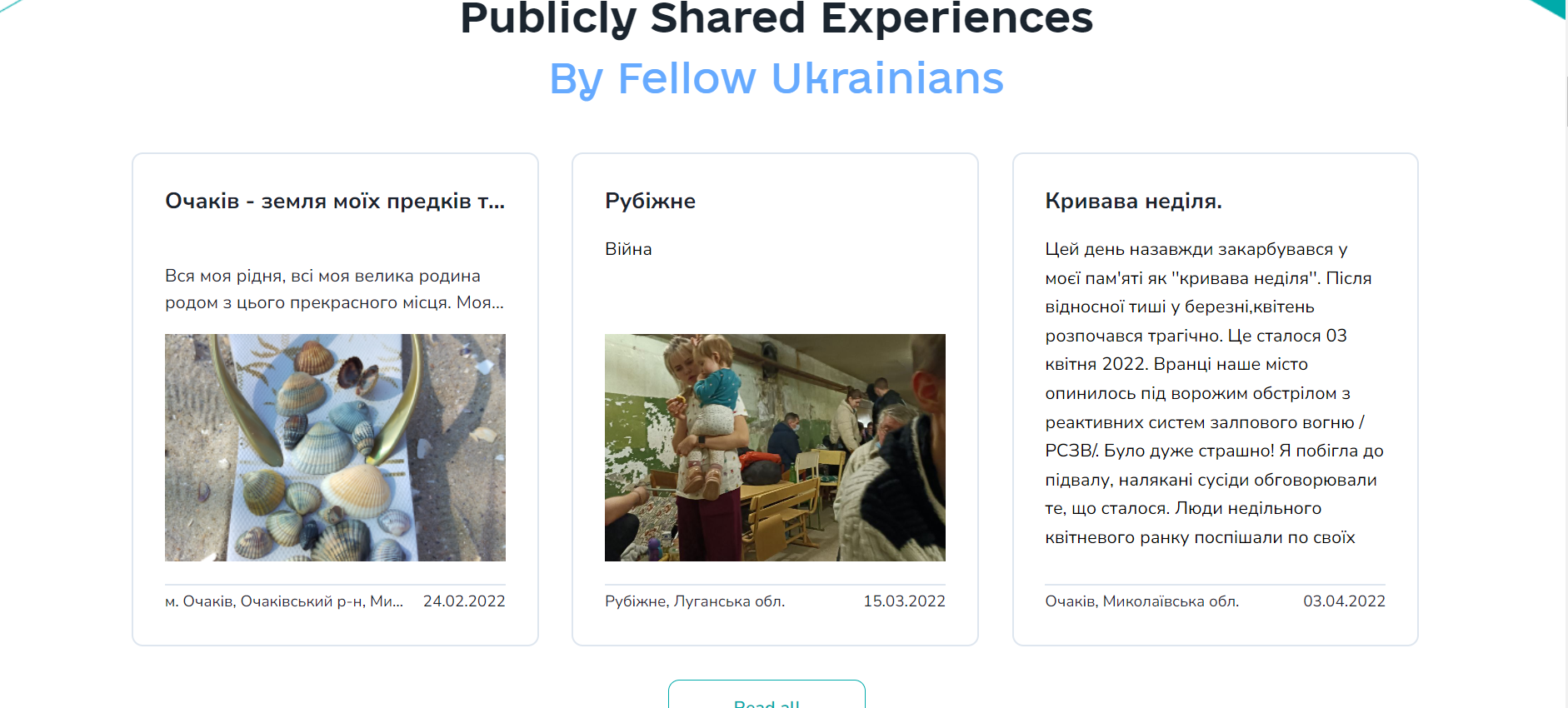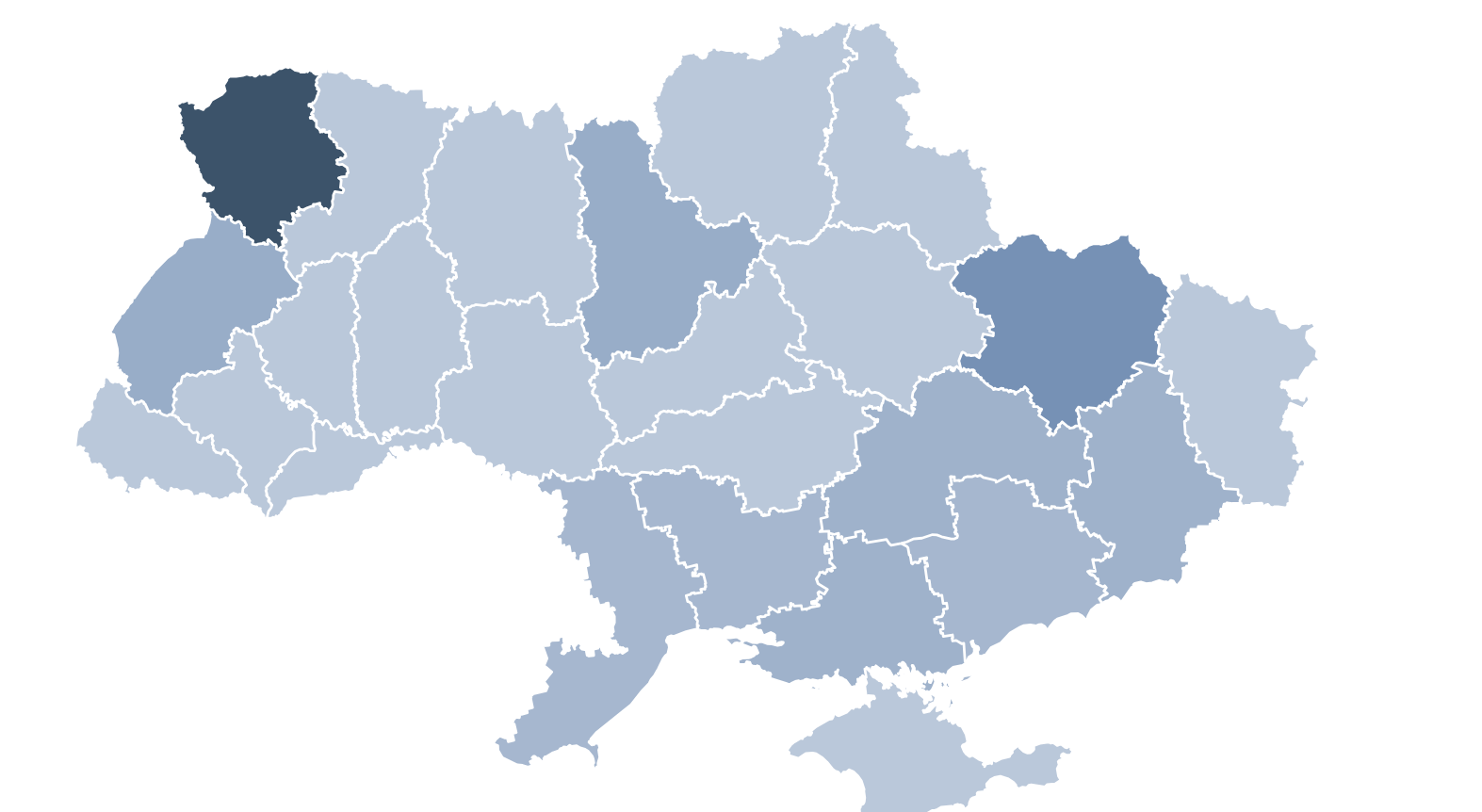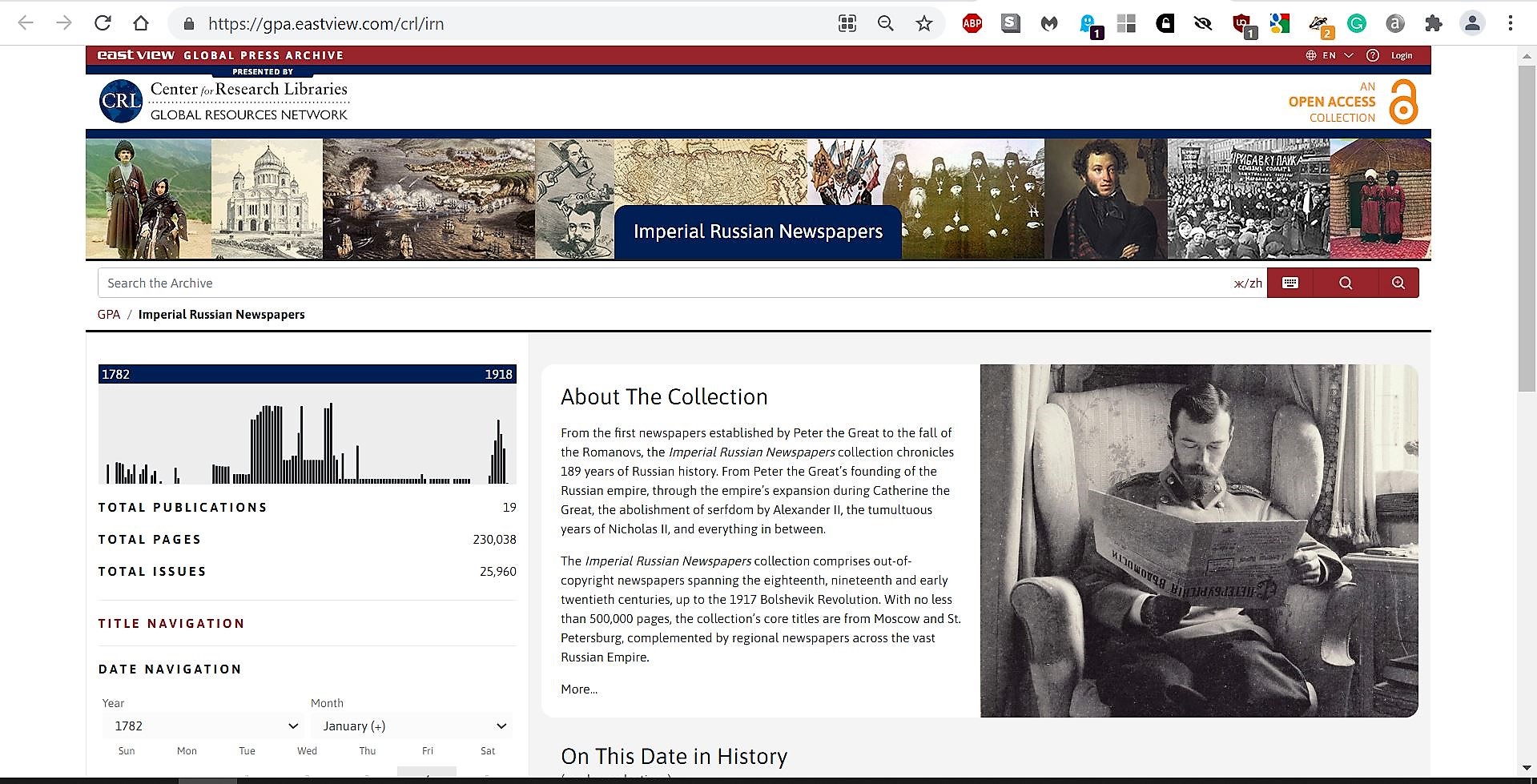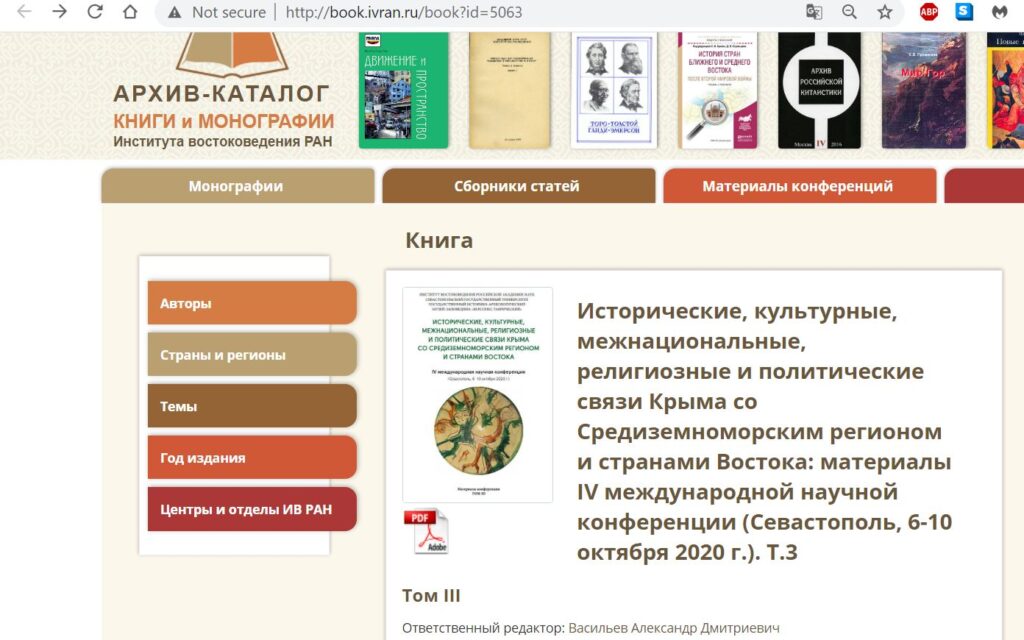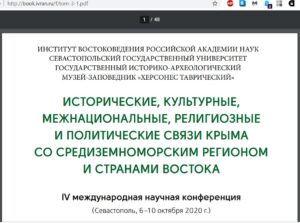Tag: Russia
UC Berkeley Library’s Online Exhibition: Capturing Struggle: Ukraine Through American and Ukrainian Lenses
The exhibition not only commemorates the unprovoked Russian aggression but also sheds light on the ongoing struggle of Ukrainians amidst civilian deaths, assaults on infrastructure, and human rights violations. It offers a glimpse into the daily lives of Ukrainians through compelling photographs. We are grateful to Brendan Hoffman (USA), Serhii Korovayny, Oksana Parfeniuk, and Serhiy Mykhalchuk (Ukraine) for generously allowing us to showcase their impactful work. Also, We want to thank Svidok and AI for Good Foundation for helping us with additional photos.
Special thanks to Professors Anastassia Fedyk, Yuriy Gorodnichenko, and Nataliia Goshylyk of the University of California Berkeley, and Professor Monica Eppinger of St. Louis University’s School of Law for their unwavering support in organizing this online exhibition and related events. These events aim to highlight the resilience of Ukrainian archivists, librarians, human rights lawyers, and publishers. We also have featured recommended readings from UC Berkeley Library’s collections based on the faculty input (In English, In Ukrainian).
The idea for bringing this exhibition to the library originated at Fulbright Ukraine and Institute of International Education Kyiv, of which the Director of both these institutions, Dr. Jessica Zychowicz, is a UC Berkeley Alumna (English, ’04). Deputy Director Inna Barysh, Communications Officer Marian Luniv, and Program Officer Mariia Kravchenko envisioned the first exhibit which took place in Vynnitsia, Ukraine, and continue to co-curate all iterations. The photographs provided by Serhii Korovayny and Serihy M. were not part of the original Fullbright exhibition and were a later curatorial addition. Fulbright Ukraine has held exhibitions at several U.S. and European universities and museums, including in locations in Berlin, Czech Republic, and Bulgaria attended by U.S. Ambassadors.
Explore the exhibition here: Capturing Struggle: Ukraine Through American and Ukrainian Lenses.
Svidok: A Story From Every Ukrainian
As the Russian invasion of Ukraine continues without a meaningful resolution in sight, Ukrainians continue to document the stories of Russian aggression in their country. One such project is Svidok. Svidok (свідок) means witness. The bilingual multimedia website allows Ukrainians to record their stories associated with Russian aggression. The purpose of recording is not only documenting their everyday lives but also to bear witness to history as it unfolds in their independent nation-state.
Below is a three-part screenshot of the Svidok’s website. The website also has a memorial board for the fallen heroes and the civilian victims.
Svidok’s self-description is below,
Svidok is your personal war journal. Where you can safely and securely store your experiences of living through the Russian invasion of Ukraine, and collect evidence of all the atrocities and war crimes that were committed by the Russians.
Svidok has been built by Ukraine’s proud citizens and friends in partnership with the AI for Good Foundation to ensure the truth of this war is accurately documented.
Про Свідок
Свідок – це ваш особистий щоденник війни. Ви можете безпечно та надійно зберігати свій досвід життя під час російського вторгнення в Україну та збирати докази всіх звірств та військових злочинів, які були скоєні росіянами.
Свідок був створений щирими громадянами та друзями України у партнерстві з Фундацією AI for Good, щоб гарантувати, що правда цієї війни буде точно задокументована.
Library Trial: Znamia Digital Archive (Soviet-era periodical)
At the library, we have set up a thirty-day trial of Znamia Digital Archive through November 18, 2023.
The extensive archive of Znamia (Знамя, Banner), a highly regarded Soviet/Russian “thick journal” (tolstyi zhurnal), covers more than nine decades and is a rich source of intellectual and artistic contributions. This monthly publication has been a vibrant platform for literature, critical analysis, philosophy, and, at times, political commentary.
Originally introduced in January 1931 as LOKAF (Локаф), an acronym for the Literary Association of the Red Army and Navy, the journal officially adopted the name Znamia, which translates to “Banner” in English, in 1933. Throughout its history, Znamia has played a crucial role in presenting the works of renowned authors such as Anna Akhmatova, Alexander Tvardovsky, Yevgeny Yevtushenko, Konstantin Paustovsky, Yuri Kazakov, and Yuri Trifonov.
During the era of Perestroika, starting in 1986, Znamia underwent a significant transformation and became one of Russia’s most widely read literary journals, serving as a herald of the Perestroika movement.
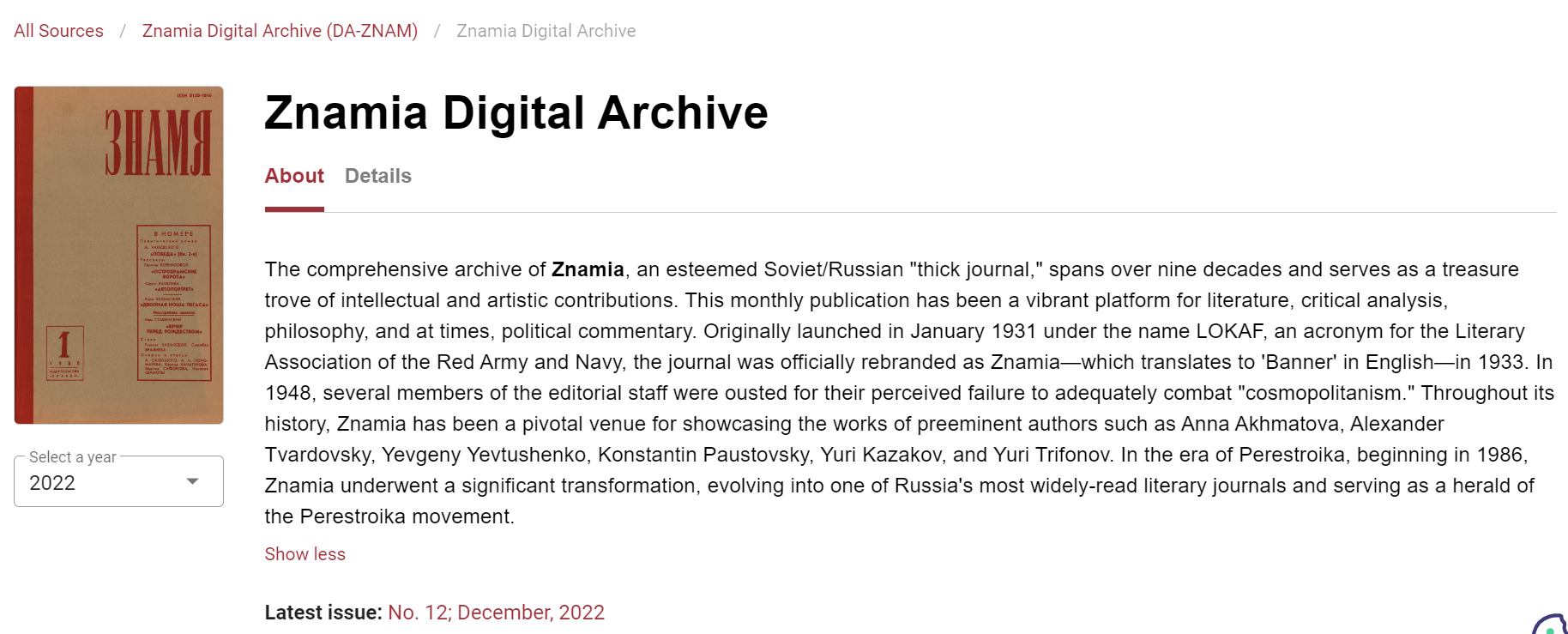
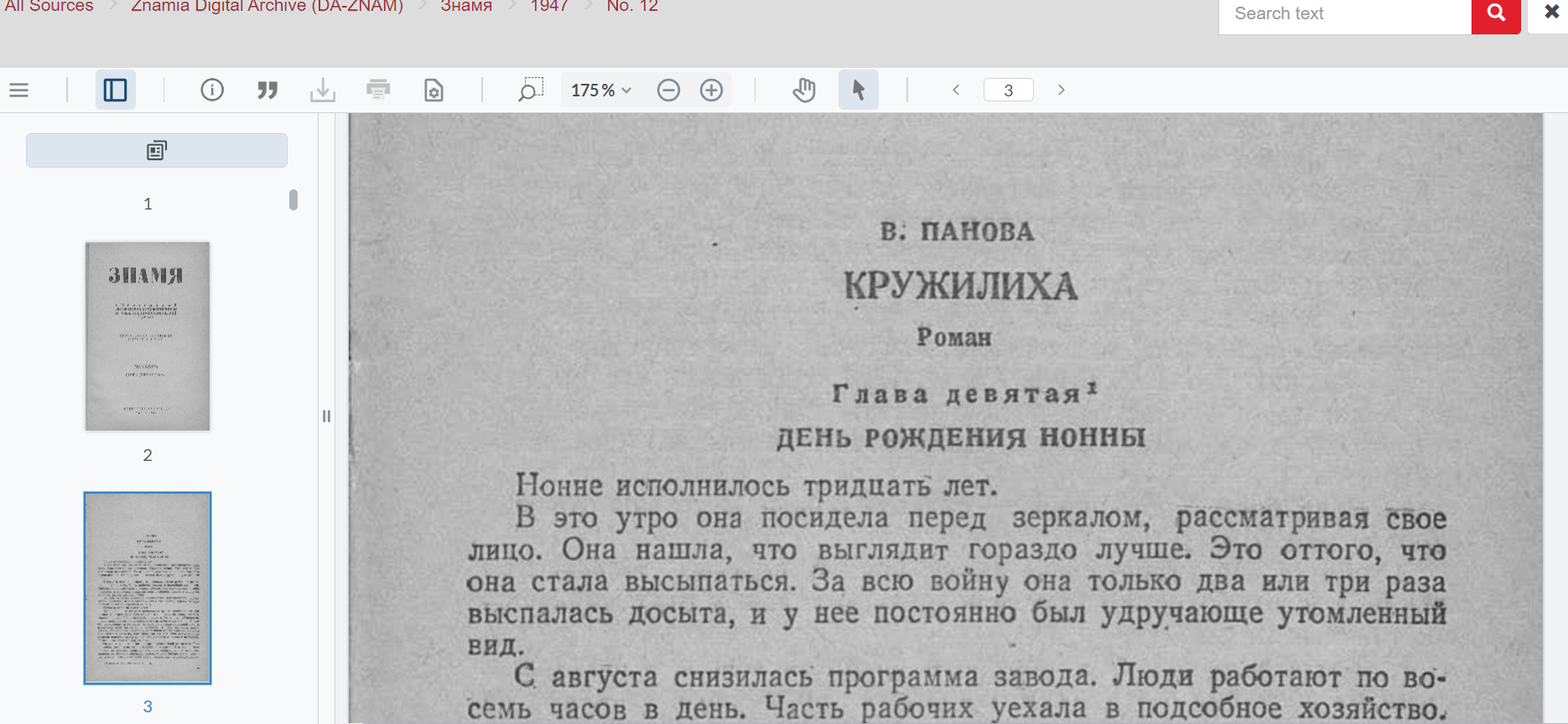
Access Link: https://libproxy.berkeley.edu/login?qurl=https%3A%2F%2Fdlib.eastview.com%2Fbrowse%2Fudb%2F6250
Primary sources: Russian language historical ebook collections
This post highlights some of the Library’s acquisitions of Russian-language historical ebook collections that may have escaped your notice.
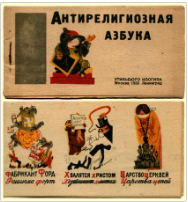 Soviet Anti-Religious Propaganda ebook collection
Soviet Anti-Religious Propaganda ebook collection
East View has digitized a collection of 280 e-books that are most emblematic of Soviet anti-religious fervor. They were published mainly in the 1920s and 1930s on a variety of atheist or anti-religious topics, with titles including Christianity versus Communism, Church versus Democracy, and The Trial of God.
Another collection from East View of 116 ebooks, originally published from 1928 to 1948, relating to the golden age of Soviet Cinema.
An ebook collection of 778 works from Brill Online. It represents works of all Russian literary avant-garde schools, most published betwen 1910-1940. According to the publisher, “the strength of this collection is in its sheer range. It contains many rare and intriguingly obscure books, as well as well-known and critically acclaimed texts, almanacs, periodicals, literary manifests. This makes it a gold mine for art historians and literary scholars alike. Represented in it are more than 30 literary groups without which the history of twentieth-century Russian literature would have been very different. Among the groups included are the Ego-Futurists and Cubo-Futurists, the Imaginists, the Constructivists, the Biocosmists, and the infamous nichevoki – who, in their most radical manifestoes, professed complete abstinence from literary creation.”
Open Access: Imperial Russian Newspapers (Center for Research Libraries)
The CRL and East View have opened the first release of content for Imperial Russian Newspapers, which is the fourth Open Access collection of titles digitized under the Global Press Archive (GPA) CRL Charter Alliance.
The Imperial Russian Newspapers collection, with a preliminary release of 230,000 pages, spans the eighteenth through early twentieth centuries and will include core titles from Moscow and St. Petersburg as well as regional newspapers. Central and regional ‘gubernskie vedomosti’ will be complemented by a selection of private newspapers.
The complete announcement is available on the CRL website at https://www.crl.edu/news/crl-and-east-view-release-open-access-imperial-russian-newspapers
Source: CRL-SEEMP
Trial of 30 Dnei Digital Archive
As a courtesy from our vendor East View, I was glad to inform you that we have set up a 30 day trial of a Russian periodical of literary importance- 30 Dnei. Below links provide access information and publisher-provided description.
The trial will end on 29th April 2021.

30 DNEI
Founded in 1925 in Moscow and in continuous print until its closure in 1941, 30 Dnei was an illustrated Soviet literary journal most famous for the serialized publications of such Soviet literary sensations as Il’f and Petrov’s The Twelve Chairs and The Golden Calf. Praised and supported by none other than Maxim Gorky the journal was conceived by its publisher as a platform for the publication of short form literature, both original and translated, and was geared towards the emerging generation of writers and the intelligentsia. Apart from helping launch and shape the literary careers of a slew of Soviet writers the journal was instrumental in introducing acclaimed works of short fiction, essays, and poetry by foreign authors as well. Some of the most important Soviet and foreign writers whose works have appeared on the pages of 30 Dnei were Vasily Grossman, Vladimir Mayakovsky, Boris Pasternak, Ernest Hemingway, Langston Hughes, Paul Valery and others. Falling into disfavor with the central government in later years, with periodical criticisms of the editorial direction of the journal appearing in Pravda and Literaturnaia gazeta, the journal would cease publication soon after Nazi Germany’s invasion of the USSR in June of 1941.
30 Dnei Digital Archive contains the complete run of the popular literary monthly journal and represents an important resource for researchers of Soviet history and literature in its formative period.
Library Database Trial: Russian-Ottoman Relations (1600-1914)-Brill-Parts I, II, III and IV
We are pleased to announce a library trial of Brill’s four parts database-Russian-Ottoman Relations.
The resource’s self-description is as follows, “Brill in cooperation with the National Library of Russia in St. Petersburg, for the first time brings together a unique collection of rare primary sources on a dynamic part of the history of Turkey, Russia, the Middle East, and Western Europe: Russian-Ottoman Relations. They include publications of relevant government documents, diplomatic reports, travel accounts that provided new details about hitherto relatively unknown regions, and fiercely political (and polemical) tracts and pamphlets designed to rally public support for one power or the other. Published across Europe over a period of two centuries, these sources provide detailed insights not only in the military ebb and flow of Russian-Ottoman relations but also in their effects on European public opinion. ”
The trial is set to start today and end on April 8, 2021
Please authenticate using your proxy or VPN credentials if you are trying to access the resource from an off-campus location.
This series currently consists of 4 parts. Please click on each hyperlink to access the full-text of each resource.
The Origins, 1600-1800
• Part 1: The Origins 1600-1800
Shifts in the Balance of Power, 1800-1853
• Part 2: Shifts in the Balance of Power, 1800-1853
The Crimean War, 1854-1856
• Part 3: The Crimean War 1854-1856
The End of the Empires, 1857-1914
• Part 4: The End of the Empires, 1857-1914

Announcing a launch of new quarterly webinar series!-Save the Date, March 18, 2021
This event is the first quarterly event in a four-part series entitled “Connecting and collecting to empower.” The series will focus on libraries and library collections from different regions of the globe to highlight the collections, print, and electronic resources from often “forgotten” or “exoticized” parts of our world. No library is an island and as curators, we are often interconnected. It is a known fact that today academic libraries can no longer serve as an archive of all that was printed from a specific region. This series is geared towards students, faculty, and researchers, and the presenters in these webinars will be faculty, academic librarians, curators, researchers, and doctoral students. Each presenter will present how the library’s collections have aided them in their academic pursuits. What were some of the challenges they had to face when they were looking for specific resources and how and if the librarians helped them overcome them?
First Webinar: The Other Asia: Central Asia and Library Collections (Spring 2021)
This 90 minutes webinar is dedicated to various library sources in Central Asia. Often, just like the Great Game in the 19th century, Central Asian Studies library collections are contested and relegated between the North American librarians for East European/ Eurasian Studies and Middle Eastern/ Near Eastern Studies. The US State Department, on the other hand, has attributed Central Asia alongside South Asia. Thus collecting Central Asian materials marks extensive collaboration among various librarians. The speakers at this webinar will speak to their efforts in collaborating to build a sustainable collection at their institutions. In this meeting, they will discuss some of the strategies they have used to develop research-level collections and collaborate with their colleagues in Central Asia. They will also focus on some open access resources.
This zoom event is free and open to all with prior registration here.
Thursday, March 18, 202111 am-12:30 PST/ 1 pm-2:30 EST
Opening Remarks: Professor David W. Roland-Holst, Agricultural and Resource Economics, UC Berkeley
Speakers:
Mr. Andy Spencer, Librarian, Middle Eastern & Central Asian Studies Librarian, University of Wisconsin-Madison
Dr. Akram Habibulla, Librarian for Middle Eastern, Islamic, and Central Eurasian Studies, Indiana University
Dr. Shah Mahmoud Hanifi, Professor of History and the founding coordinator of the Middle Eastern Communities and Migrations minor, James Madison University
Emily Laskin, Ph.D. Candidate Slavic Languages and Literatures, UC Berkeley
Organizer: Dr. Liladhar R. Pendse, UC Berkeley
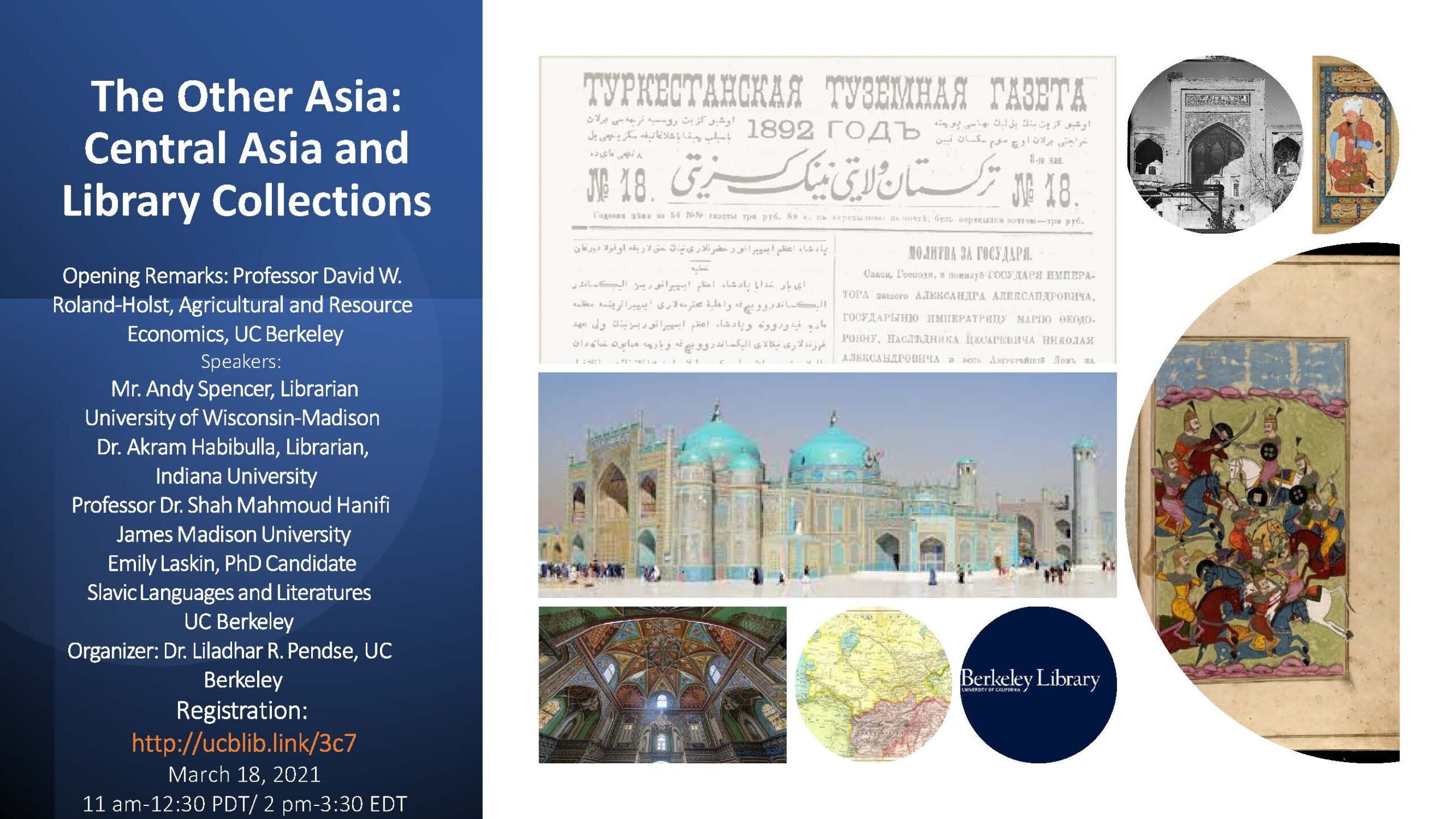
Welcome to Slavic, East European and Eurasian Studies Blog!
On the eve of “old” Russian New Year, I would like to extend a warm welcome to all who are interested in exploring with us both print and e-culture of the Slavic, East European, and Eurasian Studies collections. Often, we are questioned what Eurasia is? While there are multiple answers to the nuanced question, I will focus on Eurasian from the perspective of the often “forgotten” part of Asia- the Caucasus and Central Asia. An article on Russian culture in Luxembourg Times provides information on Russian Christmas. A brief overview of the Old and New Russian New Year is provided here.
While the New Year is here upon many in Russia, we must continue with our teaching and research under constraints imposed by the COVID-19 pandemic. I leave you to explore openly accessible books of the Institut Vostokovedeniia RAN (1818- ). The Institute of Oriental Studies of the Russian Academy of Sciences. The about section of the IV RAN‘s website provides information on the institute’s history and mission. The section of publications has basic bibliographic information on the items and provides access through the PDF. Happy Exploring!
 Below is the landing page of one of the books with PDF access.
Below is the landing page of one of the books with PDF access.
For example, if one clicks on the PDF icon as shown in the image, one can access the full-text of Istoricheskie, kulʹturnye, mezhnat︠s︡ionalʹnye, religioznye i politicheskie svi︠a︡zi Kryma so Sredizemnomorskim regionom i stranami Vostoka : IV mezhdunarodnai︠a︡ nauchnai︠a︡ konferent︠s︡ii︠a︡ (Sevastopolʹ, 6-10 okti︠a︡bri︠a︡ 2020 g.) : materialy konferent︠s︡ii, as shown below:
Until the next time, keep exploring!
Primary Sources: Gudok Digital Archive (1917-2017)
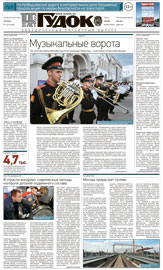 The Library has acquired the Russian daily newspaper, Gudok, which has been in continuous publication since 1917 and is one of the country’s oldest and leading trade newspapers. Since its inception, it has covered a wide range of topics dealing with the railway industry. It has also provided critical commentary on Soviet and post-Soviet Russian culture, politics, and social life. Its primary purpose has been informing the general Soviet and subsequently Russian reader with the more substantial goings on in the country in combination with a mix of biting social commentary and satire, one of the newspapers most popular features.
The Library has acquired the Russian daily newspaper, Gudok, which has been in continuous publication since 1917 and is one of the country’s oldest and leading trade newspapers. Since its inception, it has covered a wide range of topics dealing with the railway industry. It has also provided critical commentary on Soviet and post-Soviet Russian culture, politics, and social life. Its primary purpose has been informing the general Soviet and subsequently Russian reader with the more substantial goings on in the country in combination with a mix of biting social commentary and satire, one of the newspapers most popular features.
